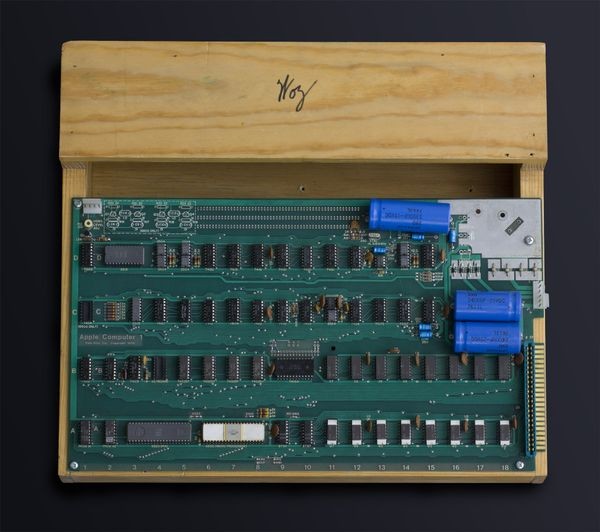"I intended to blow [Homebrew members] away with how so few and affordable chips could make a computer," Woz said in an interview. "I figured that all these people who spoke about changing society [through communication and education] would build their own for $300."
Wozniak initially pitched his design to the Hewlett-Packard Company (HP), where he was an engineering intern, and passed out his design for both hardware and software for free without any copyright or company intent. However, very few were interested. It was then that 26-year-old Wozniak teamed up with 21-year-old Jobs, who was a former high school of his. They moved production operations to the Jobs family garage and named their company Apple. In order to raise money, Jobs sold his Volkswagen minibus, and Wozniak sold his programmable calculator. The company was incorporated as Apple Computer, Inc. in January, 1977.
Their first model, the Apple I, was simply a working circuit board. However, at Jobs’s insistence, the Apple II was a stand-alone machine in a custom-molded plastic case and had a color display. Compared to the forbidding steel boxes of other early machines, the Apple II appealed to the average person.
Recognizing the management and funding required for the company to grow, Jobs convinced Regis McKenna, a well-known public relations specialist in the semiconductor industry, to represent the company and secured an investment from Michael Markkula, who became Apple’s largest shareholder and an influential member of the board of directors.
Apple went public in 1980, and its initial public offering (IPO) was the biggest since 1956. By then, the company had over 1,000 employees and made over $100 million. Due to competition from IBM, which had introduced its own line of personal computers (IBM PC) in 1981, Apple took inspiration from innovations at Xerox Corporation’s Palo Alto Research Center (PARC) and incorporated ideas such as a graphical user interface (GUI) with on-screen windows, a pointing device (mouse), and the use of icons to simplify the user experience into two new computers: the 1983 Lisa and the lower-cost, 1984 Macintosh. Jobs closely managed the Macintosh project himself and debuted the $2,500 computer to the public in the famous, science-fiction-esque, 1984 Super Bowl commercial.
In February, 1985, Wozniak left Apple amicably to become a teacher and remained an honorary employee. In contrast, due to poor sales performance, Jobs was ousted from the company in September, 1985 by the CEO John Sculley, and he went on to found NeXT.
Due to competition from cheaper alternatives running Microsoft Windows, Apple’s computer business began to suffer. When the company continued to fail to become profitable, the board of directors recruited Jobs to rejoin Apple in mid-1997. Jobs quickly revitalized the company; he announced an alliance with Microsoft and introduced the iMac. The iMac rapidly became the best-selling Mac of all-time and lifted Apple’s market share in the United States from a record low of 2.6 percent in December, 1997 to approximately 13.5 percent in August, 1998. Furthermore, Apple had a profitable fiscal year in 1998, its first since 1995.
Since then, Apple has expanded into many new markets with the introduction of new products, such as the iPod, iPhone, and numerous digital services, to become the company it is today.
Sources:
https://www.britannica.com/topic/Apple-Inc
https://en.wikipedia.org/wiki/History_of_Apple_Inc.
https://www.britannica.com/technology/Altair-computer
https://www.cnet.com/news/steve-wozniak-on-homebrew-computer-club/



I thought this post was very interesting and I liked learning about what products and ideas inspired Steve Jobs. One question I have is how did Wayne contribute to Apple?
ReplyDeleteRonald Wayne's role was to handle the administrative tasks. However, he left Apple after only 12 days, selling his 10% share in the company for $800.
Delete